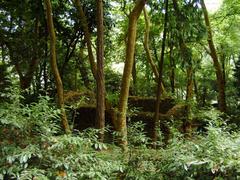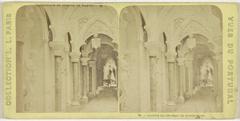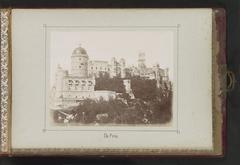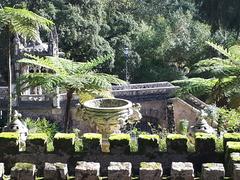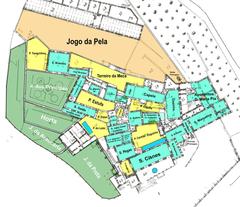Palácio Valenças Visiting Hours, Tickets, and Travel Guide – Sintra Historical Sites
Date: 14/06/2025
Introduction
Palácio Valenças stands as a refined architectural jewel in Sintra, Portugal, embodying the spirit of 19th-century Romanticism and the region’s transition from aristocratic retreat to vibrant civic center. While less internationally renowned than the exuberant Pena Palace or the mystical Quinta da Regaleira, Palácio Valenças offers visitors a unique perspective on Sintra’s layered history and architectural diversity. Commissioned in 1877 by António Ferreira dos Anjos and designed by Italian architect Giuseppe Cinatti, the palace’s blend of Venetian and Gothic Revival styles, coupled with its integration into the lush former Quinta do Duche estate, provides an authentic window into the era’s social and artistic transformations. Today, it serves as Sintra’s Municipal Assembly and Archive, with its exterior and surrounding gardens open for public enjoyment (Paisagem Cultural de Sintra; Monumentos Portugal).
This guide delivers comprehensive details on Palácio Valenças’ visiting hours, ticketing, architectural features, accessibility, travel tips, nearby attractions, and answers to frequently asked questions—ensuring you enjoy an enriching Sintra experience.
Contents
- Historical Background and Architectural Influences
- Visitor Information (Hours, Tickets, Accessibility, Getting There)
- Architectural & Artistic Highlights
- Context within Sintra’s Heritage
- Practical Tips and Nearby Attractions
- Frequently Asked Questions
- Conclusion and Summary
- List of Reliable Sources
Historical Background and Architectural Influences
Origins and Historical Evolution
Palácio Valenças traces its origins to the late 19th century. Built on the grounds of a former municipal slaughterhouse, the site was transformed in 1877 by António Ferreira dos Anjos, a wealthy Lisbon merchant. The palace’s design was entrusted to Giuseppe Cinatti, an Italian scenographer known for his work at Lisbon’s Teatro de São Carlos. Both the patron and architect died in 1879 before the palace’s completion; stewardship passed to Guilhermina Rosa Matos Anjos, Ferreira dos Anjos’ daughter, and her husband, Luís Leite Pereira Jardim, the first Count of Valenças. The palace subsequently took the Valenças family name (Paisagem Cultural de Sintra; fabrica-do-terror.com).
Architectural Style and Features
Palácio Valenças exemplifies 19th-century Romantic eclecticism, merging Venetian and Gothic Revival elements with Portuguese decorative arts. The palace’s longitudinal, asymmetric plan and open loggias evoke Venetian palatial traditions, while pointed arches and vertical stonework nod to Gothic Revival influences. The building’s integration with lush gardens—originally the Quinta do Duche, now Parque da Liberdade—reflects the Romantic ideal of harmony between architecture and nature (paisagemcultural.sintra.pt).
Decorative and Artistic Details
Distinctive features include a trompe-l’oeil azulejo panel on the main façade and, since the 1960s, a grand tile panel by modernist artist Carlos Vizeu, which displays Sintra’s coat of arms and references to the town’s history. These details blend traditional Portuguese craftsmanship with modern artistic sensibilities (lisboasecreta.co).
Visitor Information
Visiting Hours and Tickets
- Exterior Viewing: Open daily, dawn to dusk.
- Interior Access: Generally restricted to special events or official functions. Guided tours may be arranged during select occasions; check official websites for updates.
- Tickets: No charge for exterior viewing or entry to Parque da Liberdade. Event-specific tickets may apply for interior access.
Accessibility
- The palace is centrally located with pedestrian-friendly access.
- Exterior and adjacent park areas are generally accessible for visitors with mobility needs.
- Interior access may be limited due to the historic structure.
Getting There
- From Lisbon: Direct train from Rossio Station to Sintra (approx. 40 minutes), followed by a 15-minute walk or short local bus ride.
- By Bus: Local tourist buses 434 and 435 stop near Palácio Valenças and connect to other attractions (Sintra Explorers).
- By Car: Parking is limited in central Sintra, especially during peak seasons.
Architectural and Artistic Highlights
- Venetian Loggias and Balustrades: These provide both aesthetic appeal and shelter, distinguishing the palace’s exterior.
- Gothic Revival Ornamentation: Pointed arches and vertical stonework emphasize the palace’s romantic character.
- Azulejo Tilework: The tile panel simulating a doorkeeper and Carlos Vizeu’s coat of arms panel are notable artistic additions.
- Parque da Liberdade: The former botanical gardens remain open to the public, preserving the estate’s Romantic landscape design.
Context within Sintra’s Heritage
Palácio Valenças occupies a unique niche among Sintra’s historical sites. While overshadowed by more flamboyant palaces, its restrained yet sophisticated design illustrates the nuanced tastes of late 19th-century Portugal. The palace’s evolution from private estate to municipal assembly mirrors Sintra’s broader transformation into a modern civic community (paisagemcultural.sintra.pt).
Practical Tips and Nearby Attractions
Tips for Visiting
- Plan Ahead: Check Câmara Municipal de Sintra for event schedules and interior tour availability.
- Early or Late Visits: Enjoy quieter experiences in the early morning or late afternoon.
- Dress Comfortably: Sintra’s hilly, cobblestone streets require sturdy footwear.
- Weather: Sintra’s microclimate is changeable; bring a light jacket or umbrella.
Nearby Historical Sites
- Sintra National Palace: Less than 5 minutes’ walk; renowned for its twin chimneys and Mudéjar tiles (Explorial; Sintra Portugal Tourism).
- Quinta da Regaleira: 10–15 minutes’ walk; famous for mystical gardens and the Initiation Well (Cultured Voyages).
- Moorish Castle: 20–30 minutes’ walk or via Bus 434; offers panoramic views.
- Pena Palace: Accessible by Bus 434; a Romanticist masterpiece with vibrant colors and parklands.
- Palácio de Seteais & Monserrate Palace: Neoclassical and exotic gardens, respectively.
- Convento dos Capuchos & Cabo da Roca: Further afield; tranquil monastery and Europe’s westernmost cliffs (Sintra Explorers).
Accommodation and Dining
- Hotels: Options like NH Sintra Centro and Sintra Bliss Hotel are within walking distance (ATLAS Euro).
- Dining: Local specialties include Travesseiros de Sintra and Queijadas de Sintra; try regional dishes in the historic center.
Frequently Asked Questions (FAQs)
Q: What are Palácio Valenças’ regular visiting hours?
A: Exterior viewing is available daily from dawn to dusk. Interior access is restricted to special events or by appointment.
Q: Is there an admission fee?
A: No fee for exterior or gardens; event-specific tickets may apply.
Q: Is the palace wheelchair accessible?
A: The exterior and park are accessible; some interior areas may be limited.
Q: How can I arrange a guided tour?
A: Contact Sintra’s municipal offices or check official event listings for tour opportunities.
Q: What’s the best way to reach Palácio Valenças?
A: Take the train from Lisbon to Sintra, then walk or take a local bus. Parking is limited in central Sintra.
Conclusion and Summary
Palácio Valenças is a captivating yet understated facet of Sintra’s architectural and cultural landscape. Its 19th-century origins, eclectic design, and pivotal role in both aristocratic and civic histories make it a rewarding destination for travelers seeking authenticity beyond Sintra’s more crowded landmarks. While interior access is limited, the palace’s elegant façades, decorative tilework, and the adjacent Parque da Liberdade create a serene and historically rich environment.
Visitors are encouraged to check for special events and guided tours, explore neighboring attractions, and use digital resources like the Audiala app for curated experiences. Palácio Valenças exemplifies the enduring interplay between Sintra’s aristocratic legacy and its modern civic identity—an essential stop for any culturally curious traveler.
Reliable Sources and Further Reading
- Palácio Valenças: Visiting Hours, Tickets, and History – Paisagem Cultural de Sintra
- Historical Guide – Monumentos Portugal
- Visitor Information – Câmara Municipal de Sintra
- Travel and Event Guide – Sintra Explorers
- Tourism Portal – Sintra Portugal
- ATLAS Conference Site – ATLAS Euro
- Accommodation – NH Sintra Centro, Sintra Bliss Hotel
- Dining and Entry Info – Lisbon Tourist Information, Explorial, Cultured Voyages


